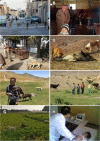Echinococcoses in Iran, Turkey, and Pakistan: Old Diseases in the New Millennium
- PMID: 34076492
- PMCID: PMC8262809
- DOI: 10.1128/CMR.00290-20
Echinococcoses in Iran, Turkey, and Pakistan: Old Diseases in the New Millennium
Abstract
Echinococcosis is considered a cosmopolitan zoonosis caused by different species of small taeniid tapeworms of the genus Echinococcus and is regarded as a neglected zoonosis. Cystic and alveolar echinococcoses are endemic diseases of Tibetan, Pamir, and Iranian plateaus. All of the countries within the Iranian plateau are affected by echinococcosis. Pakistan, Turkey, and Iran are the three most populous countries of the region, in which echinococcosis is highly endemic. The three neighboring countries share strong cultural and socioeconomic ties. The present study aimed to provide a broad review of the status of cystic and alveolar echinococcosis, summarizing the current knowledge about geographical distribution, molecular epidemiology, and transmission dynamics of Echinococcus granulosus sensu lato and Echinococcus multilocularis in this region. Additionally, we aimed to understand disease burden and risk factors as basic requirements for establishing a surveillance system and planning prevention and control programs. A considerable body of information is available on different aspects of echinococcosis in this region; however, several information and research gaps need to be filled before planning control programs. None of the countries in the region have an elaborate echinococcosis control program. Effective control programs require multi/intersectoral coordination within a One Health approach with a long-term political and administrative commitment and enhanced international collaboration among the three countries.
Keywords: Iran; Pakistan; Turkey; alveolar echinococcosis; cystic echinococcosis; epidemiology; genotypes; hydatid disease; transmission.
Figures



References
Publication types
MeSH terms
LinkOut - more resources
Full Text Sources

